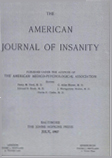PATHOLOGIC CHANGES IN SENILE PSYCHOSES AND THEIR PSYCHOBIOLOGIC SIGNIFICANCE
Abstract
The results of a pathologic study of 24 cases of senile psychoses are reported.
In all cases the cerebral cortex showed widespread nonspecific cell changes with less extensive but diffuse cell losses, an abundance of senile plaques and variable amounts of lipoid material. Neurofibril lesions of the Alzheimer type, usually in small or moderate numbers, occurred in all but two cases. The neuroglial reaction was as a rule weak. Involvement of the basal ganglia was common.
Proliferative alterations of the small cerebral vessels were regularly observed but were regarded as secondary or complicating features. Atherosclerotic changes were frequent, though in the great majority of instances they were not severe enough to occupy a prominent place in the pathologic picture.
A search for physical factors that might modify the normal aging process and be responsible for the development of a senile psychosis has proved unproductive.
There was a lack of correlation between the histologic changes and the degree of intellectual impairment. Attention was also called to the fact that equally severe alterations may be found in the brains of old persons of normal mentality.
These inconsistencies were attributed to differences in the capacity of different persons to compensate for the cerebral damage. The view is expressed that this capacity rather than the pathologic changes themselves is the determining factor in the origin of a senile psychosis.
A scrutiny of the senile group showed that strong compensatory mental reactions were usually associated with compensatory somatic processes.
The need of studying psychologic aspects of old age is emphasized, and the suggestion is advanced that the inability to meet personal problems may be the crucial factor that impairs the person's compensatory capacity, thereby leading to the development of a senile psychosis.
Access content
To read the fulltext, please use one of the options below to sign in or purchase access.- Personal login
- Institutional Login
- Sign in via OpenAthens
- Register for access
-
Please login/register if you wish to pair your device and check access availability.
Not a subscriber?
PsychiatryOnline subscription options offer access to the DSM-5 library, books, journals, CME, and patient resources. This all-in-one virtual library provides psychiatrists and mental health professionals with key resources for diagnosis, treatment, research, and professional development.
Need more help? PsychiatryOnline Customer Service may be reached by emailing [email protected] or by calling 800-368-5777 (in the U.S.) or 703-907-7322 (outside the U.S.).



